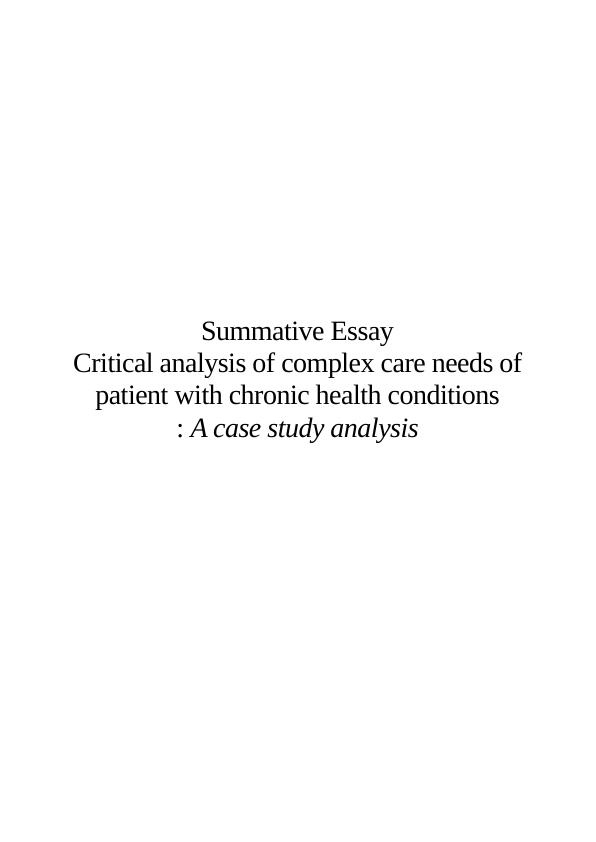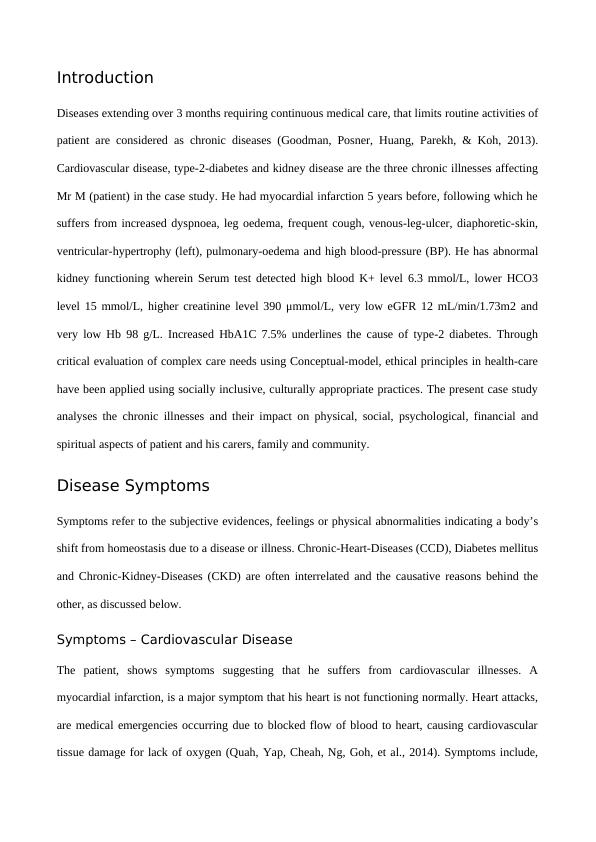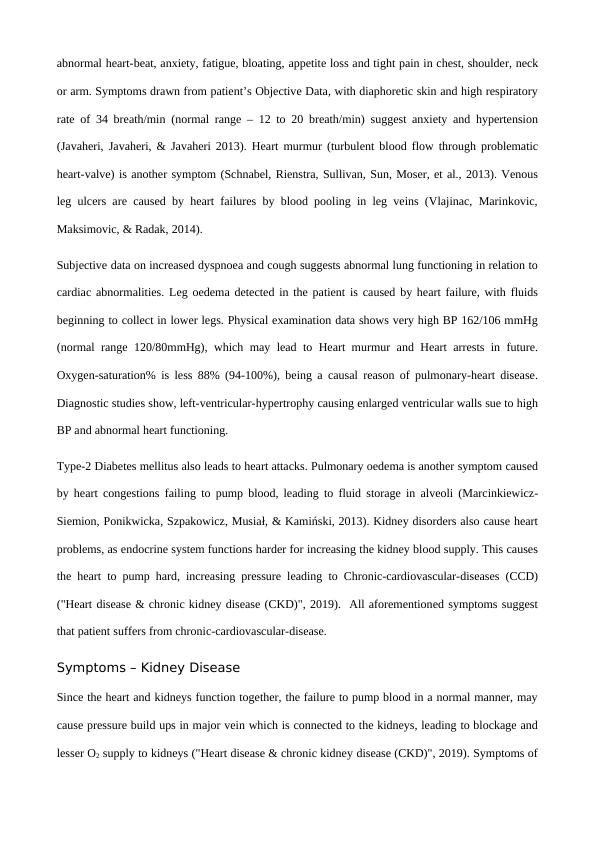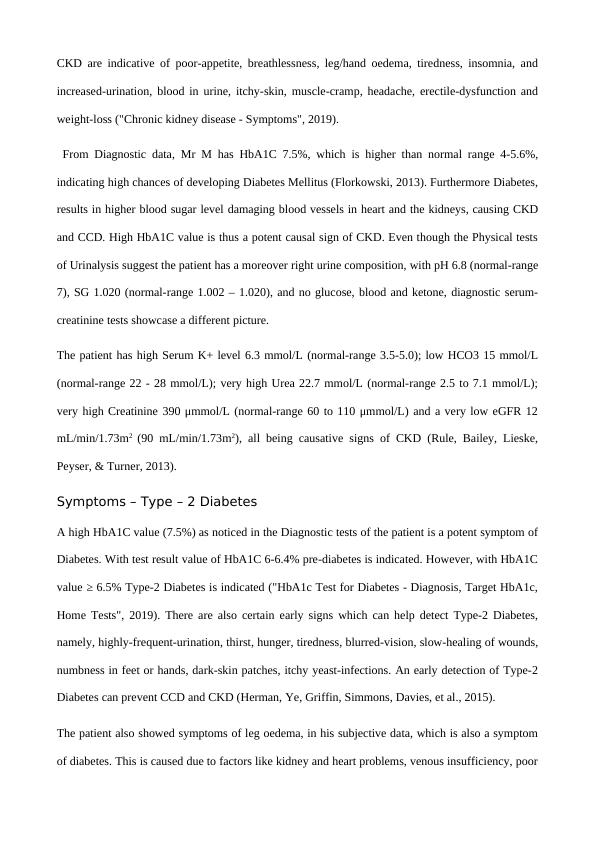Summative Essay.
Added on 2022-10-02
17 Pages5119 Words16 Views
Summative Essay
Critical analysis of complex care needs of
patient with chronic health conditions
: A case study analysis
Critical analysis of complex care needs of
patient with chronic health conditions
: A case study analysis

Introduction
Diseases extending over 3 months requiring continuous medical care, that limits routine activities of
patient are considered as chronic diseases (Goodman, Posner, Huang, Parekh, & Koh, 2013).
Cardiovascular disease, type-2-diabetes and kidney disease are the three chronic illnesses affecting
Mr M (patient) in the case study. He had myocardial infarction 5 years before, following which he
suffers from increased dyspnoea, leg oedema, frequent cough, venous-leg-ulcer, diaphoretic-skin,
ventricular-hypertrophy (left), pulmonary-oedema and high blood-pressure (BP). He has abnormal
kidney functioning wherein Serum test detected high blood K+ level 6.3 mmol/L, lower HCO3
level 15 mmol/L, higher creatinine level 390 μmmol/L, very low eGFR 12 mL/min/1.73m2 and
very low Hb 98 g/L. Increased HbA1C 7.5% underlines the cause of type-2 diabetes. Through
critical evaluation of complex care needs using Conceptual-model, ethical principles in health-care
have been applied using socially inclusive, culturally appropriate practices. The present case study
analyses the chronic illnesses and their impact on physical, social, psychological, financial and
spiritual aspects of patient and his carers, family and community.
Disease Symptoms
Symptoms refer to the subjective evidences, feelings or physical abnormalities indicating a body’s
shift from homeostasis due to a disease or illness. Chronic-Heart-Diseases (CCD), Diabetes mellitus
and Chronic-Kidney-Diseases (CKD) are often interrelated and the causative reasons behind the
other, as discussed below.
Symptoms – Cardiovascular Disease
The patient, shows symptoms suggesting that he suffers from cardiovascular illnesses. A
myocardial infarction, is a major symptom that his heart is not functioning normally. Heart attacks,
are medical emergencies occurring due to blocked flow of blood to heart, causing cardiovascular
tissue damage for lack of oxygen (Quah, Yap, Cheah, Ng, Goh, et al., 2014). Symptoms include,
Diseases extending over 3 months requiring continuous medical care, that limits routine activities of
patient are considered as chronic diseases (Goodman, Posner, Huang, Parekh, & Koh, 2013).
Cardiovascular disease, type-2-diabetes and kidney disease are the three chronic illnesses affecting
Mr M (patient) in the case study. He had myocardial infarction 5 years before, following which he
suffers from increased dyspnoea, leg oedema, frequent cough, venous-leg-ulcer, diaphoretic-skin,
ventricular-hypertrophy (left), pulmonary-oedema and high blood-pressure (BP). He has abnormal
kidney functioning wherein Serum test detected high blood K+ level 6.3 mmol/L, lower HCO3
level 15 mmol/L, higher creatinine level 390 μmmol/L, very low eGFR 12 mL/min/1.73m2 and
very low Hb 98 g/L. Increased HbA1C 7.5% underlines the cause of type-2 diabetes. Through
critical evaluation of complex care needs using Conceptual-model, ethical principles in health-care
have been applied using socially inclusive, culturally appropriate practices. The present case study
analyses the chronic illnesses and their impact on physical, social, psychological, financial and
spiritual aspects of patient and his carers, family and community.
Disease Symptoms
Symptoms refer to the subjective evidences, feelings or physical abnormalities indicating a body’s
shift from homeostasis due to a disease or illness. Chronic-Heart-Diseases (CCD), Diabetes mellitus
and Chronic-Kidney-Diseases (CKD) are often interrelated and the causative reasons behind the
other, as discussed below.
Symptoms – Cardiovascular Disease
The patient, shows symptoms suggesting that he suffers from cardiovascular illnesses. A
myocardial infarction, is a major symptom that his heart is not functioning normally. Heart attacks,
are medical emergencies occurring due to blocked flow of blood to heart, causing cardiovascular
tissue damage for lack of oxygen (Quah, Yap, Cheah, Ng, Goh, et al., 2014). Symptoms include,

abnormal heart-beat, anxiety, fatigue, bloating, appetite loss and tight pain in chest, shoulder, neck
or arm. Symptoms drawn from patient’s Objective Data, with diaphoretic skin and high respiratory
rate of 34 breath/min (normal range – 12 to 20 breath/min) suggest anxiety and hypertension
(Javaheri, Javaheri, & Javaheri 2013). Heart murmur (turbulent blood flow through problematic
heart-valve) is another symptom (Schnabel, Rienstra, Sullivan, Sun, Moser, et al., 2013). Venous
leg ulcers are caused by heart failures by blood pooling in leg veins (Vlajinac, Marinkovic,
Maksimovic, & Radak, 2014).
Subjective data on increased dyspnoea and cough suggests abnormal lung functioning in relation to
cardiac abnormalities. Leg oedema detected in the patient is caused by heart failure, with fluids
beginning to collect in lower legs. Physical examination data shows very high BP 162/106 mmHg
(normal range 120/80mmHg), which may lead to Heart murmur and Heart arrests in future.
Oxygen-saturation% is less 88% (94-100%), being a causal reason of pulmonary-heart disease.
Diagnostic studies show, left-ventricular-hypertrophy causing enlarged ventricular walls sue to high
BP and abnormal heart functioning.
Type-2 Diabetes mellitus also leads to heart attacks. Pulmonary oedema is another symptom caused
by heart congestions failing to pump blood, leading to fluid storage in alveoli (Marcinkiewicz-
Siemion, Ponikwicka, Szpakowicz, Musiał, & Kamiński, 2013). Kidney disorders also cause heart
problems, as endocrine system functions harder for increasing the kidney blood supply. This causes
the heart to pump hard, increasing pressure leading to Chronic-cardiovascular-diseases (CCD)
("Heart disease & chronic kidney disease (CKD)", 2019). All aforementioned symptoms suggest
that patient suffers from chronic-cardiovascular-disease.
Symptoms – Kidney Disease
Since the heart and kidneys function together, the failure to pump blood in a normal manner, may
cause pressure build ups in major vein which is connected to the kidneys, leading to blockage and
lesser O2 supply to kidneys ("Heart disease & chronic kidney disease (CKD)", 2019). Symptoms of
or arm. Symptoms drawn from patient’s Objective Data, with diaphoretic skin and high respiratory
rate of 34 breath/min (normal range – 12 to 20 breath/min) suggest anxiety and hypertension
(Javaheri, Javaheri, & Javaheri 2013). Heart murmur (turbulent blood flow through problematic
heart-valve) is another symptom (Schnabel, Rienstra, Sullivan, Sun, Moser, et al., 2013). Venous
leg ulcers are caused by heart failures by blood pooling in leg veins (Vlajinac, Marinkovic,
Maksimovic, & Radak, 2014).
Subjective data on increased dyspnoea and cough suggests abnormal lung functioning in relation to
cardiac abnormalities. Leg oedema detected in the patient is caused by heart failure, with fluids
beginning to collect in lower legs. Physical examination data shows very high BP 162/106 mmHg
(normal range 120/80mmHg), which may lead to Heart murmur and Heart arrests in future.
Oxygen-saturation% is less 88% (94-100%), being a causal reason of pulmonary-heart disease.
Diagnostic studies show, left-ventricular-hypertrophy causing enlarged ventricular walls sue to high
BP and abnormal heart functioning.
Type-2 Diabetes mellitus also leads to heart attacks. Pulmonary oedema is another symptom caused
by heart congestions failing to pump blood, leading to fluid storage in alveoli (Marcinkiewicz-
Siemion, Ponikwicka, Szpakowicz, Musiał, & Kamiński, 2013). Kidney disorders also cause heart
problems, as endocrine system functions harder for increasing the kidney blood supply. This causes
the heart to pump hard, increasing pressure leading to Chronic-cardiovascular-diseases (CCD)
("Heart disease & chronic kidney disease (CKD)", 2019). All aforementioned symptoms suggest
that patient suffers from chronic-cardiovascular-disease.
Symptoms – Kidney Disease
Since the heart and kidneys function together, the failure to pump blood in a normal manner, may
cause pressure build ups in major vein which is connected to the kidneys, leading to blockage and
lesser O2 supply to kidneys ("Heart disease & chronic kidney disease (CKD)", 2019). Symptoms of

CKD are indicative of poor-appetite, breathlessness, leg/hand oedema, tiredness, insomnia, and
increased-urination, blood in urine, itchy-skin, muscle-cramp, headache, erectile-dysfunction and
weight-loss ("Chronic kidney disease - Symptoms", 2019).
From Diagnostic data, Mr M has HbA1C 7.5%, which is higher than normal range 4-5.6%,
indicating high chances of developing Diabetes Mellitus (Florkowski, 2013). Furthermore Diabetes,
results in higher blood sugar level damaging blood vessels in heart and the kidneys, causing CKD
and CCD. High HbA1C value is thus a potent causal sign of CKD. Even though the Physical tests
of Urinalysis suggest the patient has a moreover right urine composition, with pH 6.8 (normal-range
7), SG 1.020 (normal-range 1.002 – 1.020), and no glucose, blood and ketone, diagnostic serum-
creatinine tests showcase a different picture.
The patient has high Serum K+ level 6.3 mmol/L (normal-range 3.5-5.0); low HCO3 15 mmol/L
(normal-range 22 - 28 mmol/L); very high Urea 22.7 mmol/L (normal-range 2.5 to 7.1 mmol/L);
very high Creatinine 390 μmmol/L (normal-range 60 to 110 μmmol/L) and a very low eGFR 12
mL/min/1.73m2 (90 mL/min/1.73m2), all being causative signs of CKD (Rule, Bailey, Lieske,
Peyser, & Turner, 2013).
Symptoms – Type – 2 Diabetes
A high HbA1C value (7.5%) as noticed in the Diagnostic tests of the patient is a potent symptom of
Diabetes. With test result value of HbA1C 6-6.4% pre-diabetes is indicated. However, with HbA1C
value ≥ 6.5% Type-2 Diabetes is indicated ("HbA1c Test for Diabetes - Diagnosis, Target HbA1c,
Home Tests", 2019). There are also certain early signs which can help detect Type-2 Diabetes,
namely, highly-frequent-urination, thirst, hunger, tiredness, blurred-vision, slow-healing of wounds,
numbness in feet or hands, dark-skin patches, itchy yeast-infections. An early detection of Type-2
Diabetes can prevent CCD and CKD (Herman, Ye, Griffin, Simmons, Davies, et al., 2015).
The patient also showed symptoms of leg oedema, in his subjective data, which is also a symptom
of diabetes. This is caused due to factors like kidney and heart problems, venous insufficiency, poor
increased-urination, blood in urine, itchy-skin, muscle-cramp, headache, erectile-dysfunction and
weight-loss ("Chronic kidney disease - Symptoms", 2019).
From Diagnostic data, Mr M has HbA1C 7.5%, which is higher than normal range 4-5.6%,
indicating high chances of developing Diabetes Mellitus (Florkowski, 2013). Furthermore Diabetes,
results in higher blood sugar level damaging blood vessels in heart and the kidneys, causing CKD
and CCD. High HbA1C value is thus a potent causal sign of CKD. Even though the Physical tests
of Urinalysis suggest the patient has a moreover right urine composition, with pH 6.8 (normal-range
7), SG 1.020 (normal-range 1.002 – 1.020), and no glucose, blood and ketone, diagnostic serum-
creatinine tests showcase a different picture.
The patient has high Serum K+ level 6.3 mmol/L (normal-range 3.5-5.0); low HCO3 15 mmol/L
(normal-range 22 - 28 mmol/L); very high Urea 22.7 mmol/L (normal-range 2.5 to 7.1 mmol/L);
very high Creatinine 390 μmmol/L (normal-range 60 to 110 μmmol/L) and a very low eGFR 12
mL/min/1.73m2 (90 mL/min/1.73m2), all being causative signs of CKD (Rule, Bailey, Lieske,
Peyser, & Turner, 2013).
Symptoms – Type – 2 Diabetes
A high HbA1C value (7.5%) as noticed in the Diagnostic tests of the patient is a potent symptom of
Diabetes. With test result value of HbA1C 6-6.4% pre-diabetes is indicated. However, with HbA1C
value ≥ 6.5% Type-2 Diabetes is indicated ("HbA1c Test for Diabetes - Diagnosis, Target HbA1c,
Home Tests", 2019). There are also certain early signs which can help detect Type-2 Diabetes,
namely, highly-frequent-urination, thirst, hunger, tiredness, blurred-vision, slow-healing of wounds,
numbness in feet or hands, dark-skin patches, itchy yeast-infections. An early detection of Type-2
Diabetes can prevent CCD and CKD (Herman, Ye, Griffin, Simmons, Davies, et al., 2015).
The patient also showed symptoms of leg oedema, in his subjective data, which is also a symptom
of diabetes. This is caused due to factors like kidney and heart problems, venous insufficiency, poor

End of preview
Want to access all the pages? Upload your documents or become a member.
Related Documents
Article | MANAGING CHRONIC DISORDERS.lg...
|16
|4339
|20
Pathophysiology of Congestive Heart Failurelg...
|12
|2522
|61
Chronic Heart Failure Question and Answer 2022lg...
|10
|2569
|22
Congestive Heart Failure Assignment Solutionlg...
|14
|2990
|58
Clinical Care Assignment PDFlg...
|14
|4275
|75
Chronic Kidney Disease: Case Study and Discussionlg...
|5
|1570
|166
